Hands-on with my first Snapdragon 8 Elite phone and it’s too hot to handle.
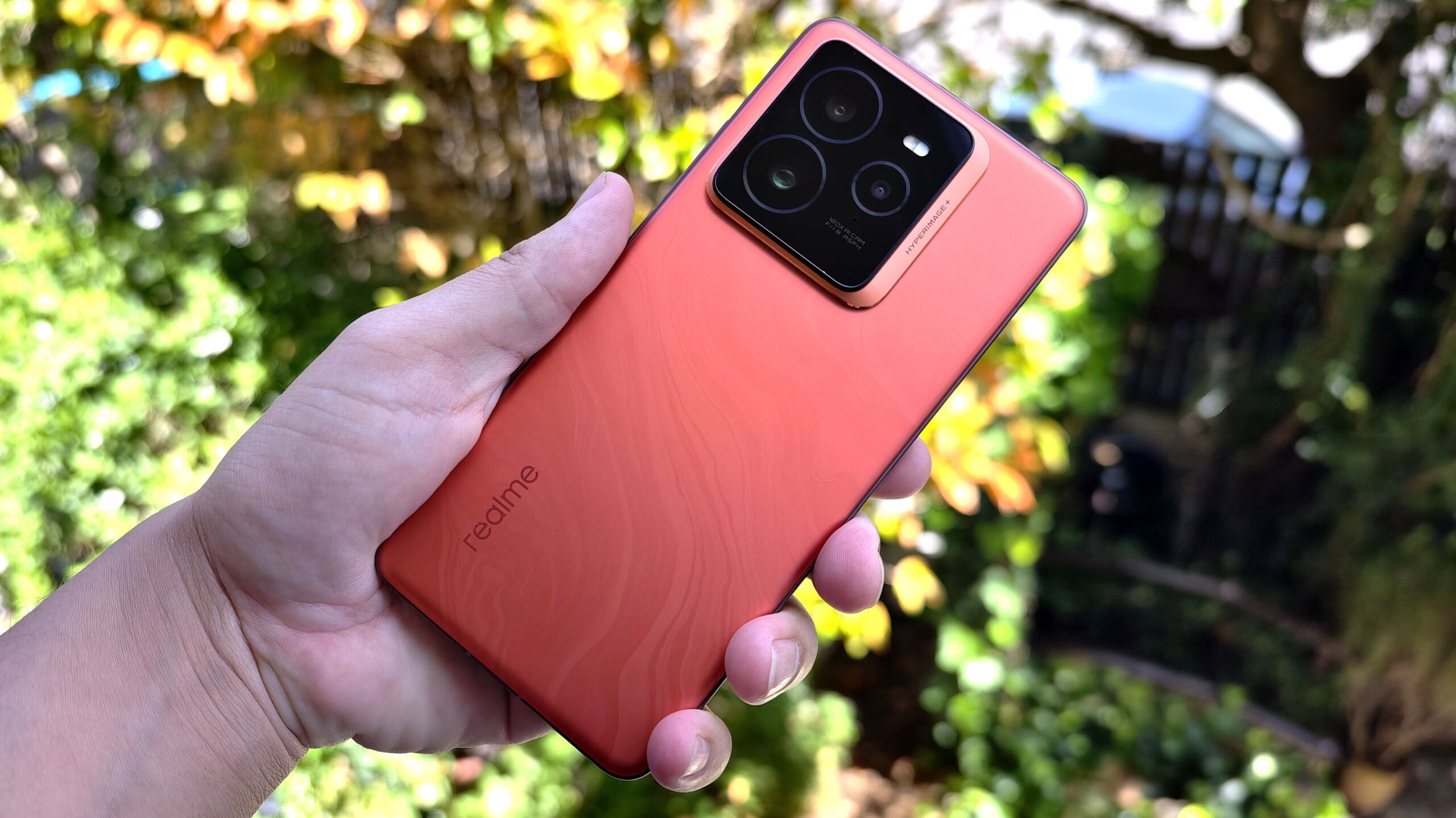
Hadlee Simons / Android Authority
The Snapdragon 8 Elite was released last week, and we’ve already seen the first phone with this chipset launch in China in the Xiaomi 15 series. However, Realme hopes the Realme GT7 Pro will be the first widely available Snapdragon 8 Elite device on the market.
The handset is scheduled to launch in China on November 4 before expanding to more markets (including Europe) from mid-November. I have the phone in my hands, so how does the Snapdragon 8 Elite chip fare?
What you’re getting (on paper)
The Snapdragon 8 Elite is Qualcomm’s most ambitious smartphone processor in years, bringing brand-new custom Oryon CPU cores for the first time. The chip offers two prime cores clocked at a blazing 4.32GHz and six performance cores clocked at 3.53GHz. There are no little cores here, aping Apple and MediaTek’s approaches. Qualcomm says you should expect a 45% boost to single-core and multi-core performance over the Snapdragon 8 Gen 3, along with a 44% efficiency gain.
The Snapdragon 8 Elite also has an overhauled GPU, using a so-called sliced architecture. This change means the shader cores and fixed function blocks are split into distinct slices for improved performance and efficiency, allowing for more granular power control. Qualcomm says you should expect 40% faster graphics and 35% faster ray tracing performance.
This Snapdragon 8 Elite phone couldn’t finish stress tests
I started out running the phone through 3DMark’s GPU stress tests to give us a good idea of sustained performance. Unfortunately, the Realme GT7 Pro killed the 3DMark app midway through our three stress tests (Wild Life Stress Test, Wild Life Extreme Stress Test, and Solar Bay Stress Test). The phone was uncomfortably hot at this point, and it displayed heat-related warnings upon shutting down the app. The device also briefly limited me to only using a few apps, allowing me to make calls and very little else.
The Realme GT7 Pro couldn’t finish any GPU stress tests at first due to major heating issues.
I tried switching from the default balanced performance mode to the phone’s power-saving mode, but this didn’t make a difference — the 3DMark app still shut down due to excessive heat. Data collected during these failed runs reveals that the phone hit a toasty peak of 46 degrees Celsius. This is deeply concerning.
I decided to run a disguised version of 3DMark to bypass any possible benchmark-optimizing shenanigans on Realme’s part, using the balanced profile once again. I was finally able to complete the three stress tests, revealing a stability of 68.7%, 66.7%, and 64.3%, respectively. The graphs below show that the phone suffered steep performance drops at first and then delivered rock-solid stability from roughly midway through. This stable performance wasn’t on par with peak Samsung Galaxy S24 Ultra scores, but the Realme phone still maintained a healthy performance advantage on every run.

Hadlee Simons / Android Authority
The phone was hot to the touch after these successful tests, too. In fact, the app reported a peak temperature of 45 degrees Celsius in the Wild Life stress test, which was two to three degrees higher than the Google Pixel 9 Pro XL and Galaxy S24 Ultra’s peak temperatures. Oddly enough, the GT7 Pro’s temperature in the two other stress tests was pretty much in line with those of Google and Samsung’s phones.
Check out the graph below, which compares the Realme and Samsung phones. This shows that the Galaxy phone was actually hotter than the Snapdragon 8 Elite handset until the halfway point. The Samsung phone’s temperatures then stabilize, and we get some very minor performance wobbles. Meanwhile, the Realme handset delivers extremely stable performance but sees gradually rising temperatures that take it well past the S24 Ultra. I’m concerned that long gaming sessions might come to a premature end on this hardware if the titles aren’t optimized by the OEM or chipmaker. Once again, bear in mind that this test used a spoofed (and cooler running) version of the 3DMark app.
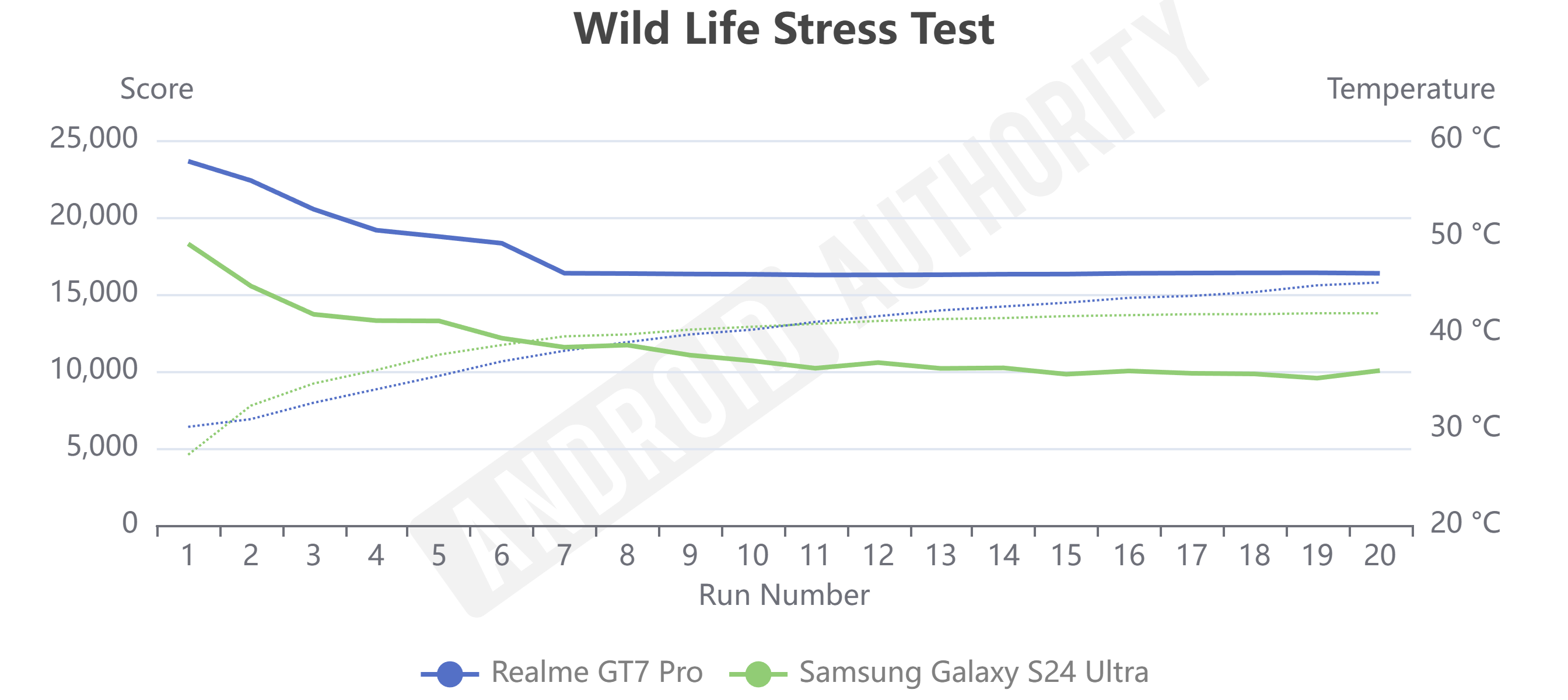
Hadlee Simons / Android Authority
This behavior made me wonder about our CPU benchmarks as well. So we installed a spoofed version of Geekbench 6 to determine if Realme was indeed turning up the wick when it detects benchmark apps. The results show that single-core and multi-core CPU performance drops by a massive 63% and 47%, respectively, compared to the standard Geekbench 6 app.
Benchmark results suggest very different performance points for select apps.
Single-core scores actually drop below the Pixel 9 Pro XL, while multi-core scores are in the same territory as the Tensor chip. That’s an alarming performance downgrade for apps that aren’t on Realme’s performance optimization list.
What’s actually going on with this Snapdragon 8 Elite phone?
We suspected that this is a case of benchmark “cheating” gone wrong by Realme. The phone runs the stock 3DMark app at virtually full tilt with no regard for device temperature until it crosses a critical thermal threshold. What’s more concerning, though, is that even the spoofed app yields hot temperatures, albeit not enough to kill the app, as was the case with the stock benchmark. This suggests that even in the best-case scenario, Realme’s Snapdragon 8 Elite phone is stubbornly trying to stick to a high level of sustained performance at the expense of cooler temperatures. The worst-case scenario is that the company disregards thermal considerations entirely in favor of performance when it detects a benchmark app. Only the phone’s built-in safety measures are saving us in this worst-case scenario.
Realme issued a statement to Android Authority confirming issues with running 3DMark’s stress tests on the GT7 Pro:
Regarding the 3DMark issue, we have also noticed the same situation. We will release an updated version; please restart your phone tomorrow or the day after, and you should be able to run tests with the genuine software.
The company also claimed that the inflated GeekBench 6 scores were due to “targeted optimizations in terms of temperature and performance management,” adding that this was a “common industry practice.” Of course, there’s a difference between a slight performance drop and the dramatically reduced CPU scores we’re seeing here.
Realme confirmed issues running GPU stress tests on its Snapdragon 8 Elite phone, while admitting that it performed ‘targeted optimizations’ for GeekBench 6.
For what it’s worth, we have another Snapdragon 8 Elite phone under embargo and can confirm that we were also able to complete the three stress tests just fine using a spoofed app. It also doesn’t see such a major performance downgrade with the spoofed GeekBench 6 app. We were also able to successfully run the Wild Life Stress Test on a Qualcomm reference device at the Snapdragon Summit. So it’s clear that other phones (commercial or otherwise) can complete the benchmark.
This wouldn’t be the first time a smartphone maker was caught gaming benchmarks, nor would it be the first time Realme was accused of this type of manipulation. The company was previously banned by Antutu over allegations of benchmark cheating back in 2021.
How does the GT7 Pro hold up against Qualcomm’s claims?
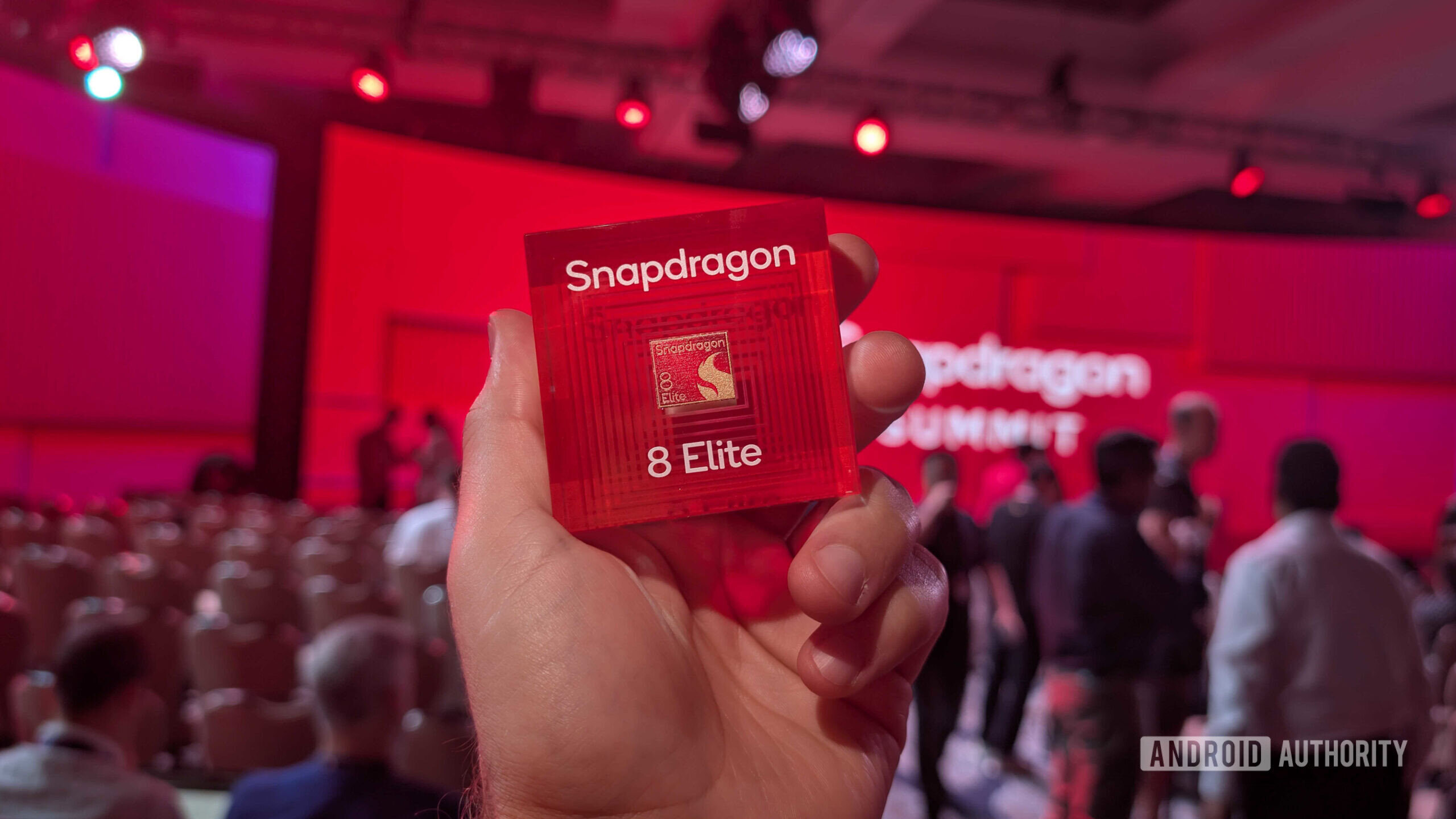
C. Scott Brown / Android Authority
We still couldn’t pass up the opportunity to see how close a commercial Snapdragon 8 Elite phone gets to Qualcomm’s performance claims. We ran three GeekBench 6 tests in quick succession on the GT7 Pro using the balanced performance mode and calculated the average scores. We must emphasize once again that this is using the standard app that’s the subject of “targeted optimizations” rather than the spoofed app.
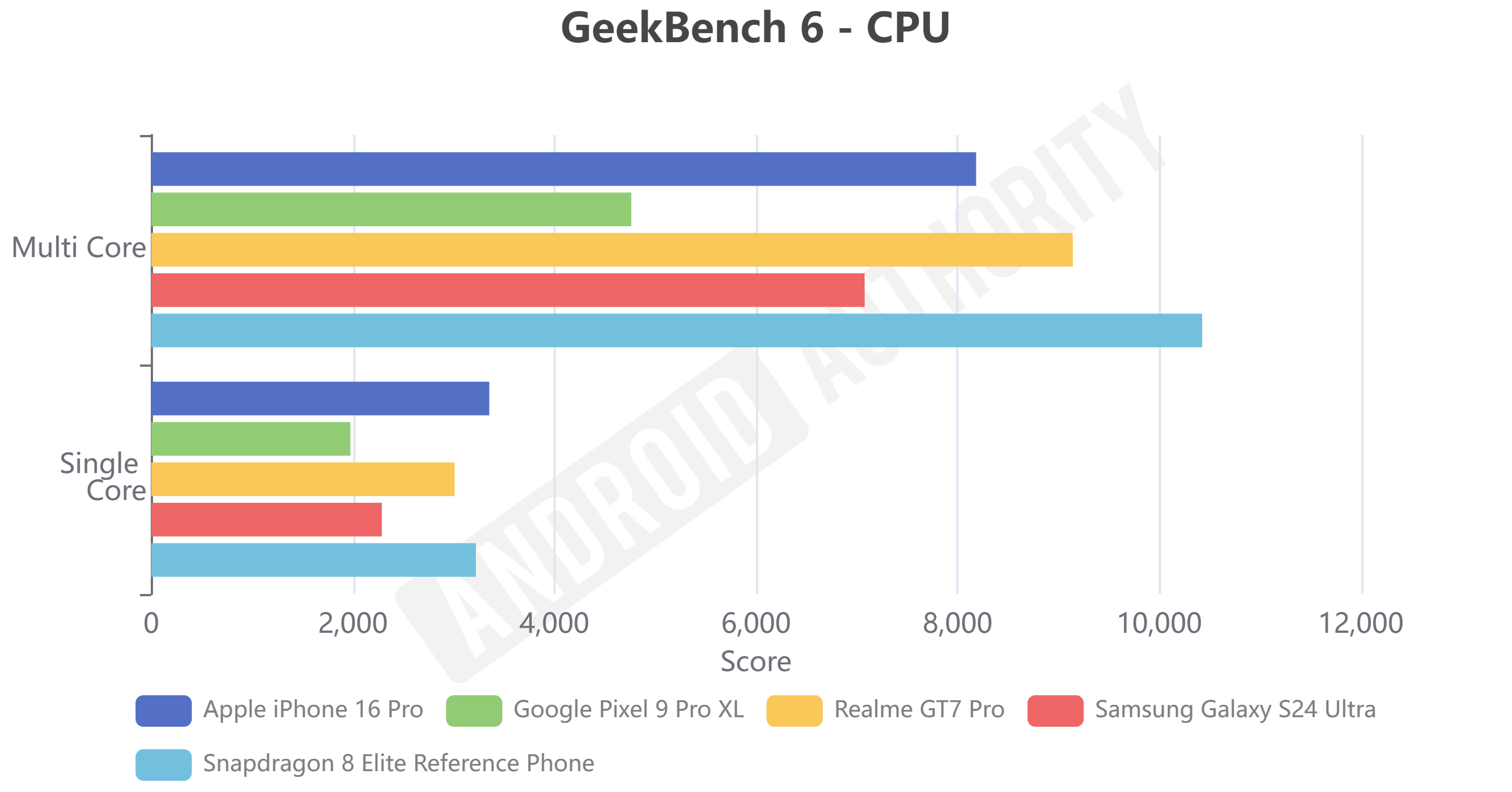
Hadlee Simons / Android Authority
The good news is that the Realme GT7 Pro is close to the Apple A18 Pro inside the iPhone 16 Pro, with Apple winning by about 11% in single-core scores and the Realme phone beating Apple’s chip by ~12% in multi-core scores. The latter result is no surprise, as the Snapdragon 8 Elite has two more CPU cores than the Apple chip. Nevertheless, we’re curious to see if other upcoming flagship Android phones might be able to beat the A18 Pro across the board.
Meanwhile, the GT7 Pro lost to the Snapdragon 8 Elite reference device by ~6.5% in single-core performance, which isn’t a huge disparity but still noteworthy. However, this performance gap widens when we look at multi-core scores.
The Realme GT7 Pro falls slightly short of Qualcomm’s projections.
These are some impressive year-on-year improvements in isolation, but some way off Qualcomm’s 45% claims for single-core and multi-core performance. This is especially apparent when it comes to multi-core results. But what about GPU-related results?

Hadlee Simons / Android Authority
I ran some one-off GPU benchmarks to see how the Realme GT7 Pro fares against the competition. These scores were obtained via the disguised 3DMark app. The standard Wild Life test yields a 29% boost over the Galaxy S24 Ultra’s Snapdragon 8 Gen 3, while the Extreme test sees a 27% gain over the Samsung phone. Finally, the Solar Bay test is purely for ray tracing performance, and we see a 27% boost over the S24 Ultra. Unfortunately, the Pixel 9 phones don’t support ray tracing.
These GT7 Pro scores don’t quite match Qualcomm’s promise of 40% faster graphics, although the phone’s ray tracing performance certainly gets close to the chipmaker’s claimed 35% increase.
I’m guessing these lower-than-advertised CPU and GPU scores could be due to software tuning or inadequate cooling. We initially suspected that slower memory and/or storage could be a factor too, but Realme said our 16GB/512GB GT7 Pro has modern LPDDR5X RAM and UFS 4.0 storage. Meanwhile, the Snapdragon reference phone used 24GB of LPDDR5X RAM and UFS 4.0 storage. Still, it’s entirely possible that other Snapdragon 8 Elite phones could meet or at least get closer to these claims with improved software optimization and cooling.
Does this mean the Snapdragon 8 Elite is a dud?
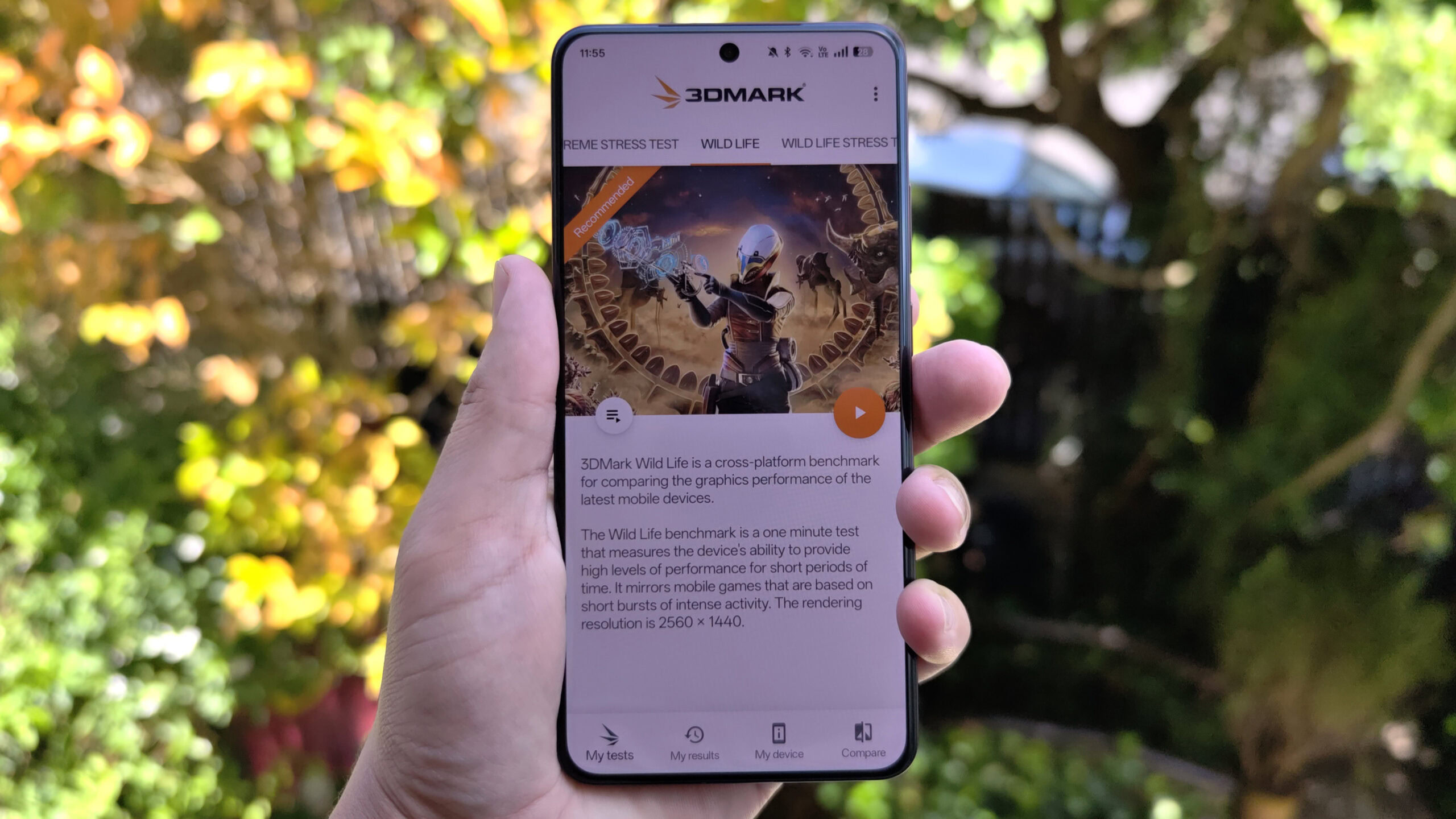
Hadlee Simons / Android Authority
It’s too early to definitively judge the Snapdragon 8 Elite, given that we’ve only comprehensively tested one smartphone with the processor. I’m still concerned by the Realme GT7 Pro’s overheating. I’m hoping these issues are largely due to the OEM’s benchmark gaming rather than a major issue with the Snapdragon chip. What’s also concerning is that benchmarks from a disguised app still yielded some high temperatures yet refused to budge on performance.
This benchmark manipulation is also lamentable because even if the GT7 Pro doesn’t actually meet Qualcomm’s claims, it’s clear that the Snapdragon 8 Elite is still a significant improvement over the Snapdragon 8 Gen 3.
Source link



